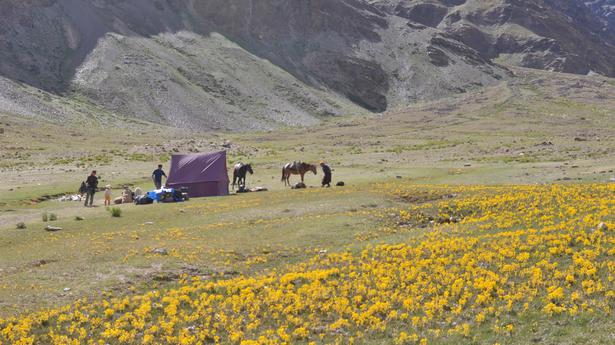
Road to Zanskar: This remote village now has easy access to cash, clothes, phones and hospitals
The Hindu
For almost every other Zanskari, the convenience of being able to travel home this fast is little short of miraculous
We set off for Zanskar in the dark. Along with my husband Tanzin and our two-year-old daughter, we have with us my mother-in-law Abe le, nephew Kalsang, a cook, and a driver. The dawn when it comes is pink as rose quartz. We bump up rough track for what feels like eternity until we are stopped short of the pass by a flood so deep even the 4x4 baulks. Tanzin, Kalsang and the cook get out, unload all the food we have brought for the three-day trek ahead, and wade precariously through the icy torrent, with trays of egg and bundles of sabjibalanced in their arms.
Abe le throws sacred red barley grains wildly about the vehicle and practically shouts her mantras above the crash of water. We rev to roaring, face the flood, and cross without mishap. At the top of Shinku la pass, the track peters out completely. Kalsang’s father meets us with four sturdy mountain ponies. We begin the long walk home to Testa, through snow, mud, water, over single-plank bridges, fording flooded rivers on horseback, and scrabbling across rocks when there is no path. Abe le suffers nose bleeds. The wind sings sharply, coldly, in our ears. We arrive at Testa after three days and nights on the trot.
Cut to five years later. Testa now has its first motorable road. Our three-day trek becomes a six-hour drive from Lahaul. Abe le, now 85, is violently car-sick for most of the journey.
For almost every other Zanskari I meet, however, the convenience of being able to travel home this fast is little short of miraculous: suddenly, there is immediate access to hospitals, to technology and cashpoints. Bread, sugar, phones, satellite dishes, clothes, shoes, and cash, a means of exchange unknown in Zanskar until about 20 years ago. Almost gone are the days when jewels changed hands for land and eldest daughters inherited rock coral and turquoise headdresses so heavy, wearing them would cause the brides to go cross-eyed during the marriage ceremony.
“Things used to be done in a good way,” Tanzin’s sister-in-law tells me as we sit around, drinking tea and rolling small balls of tasty tsampa in the communal living room of Testa Kha; for instance, she tells me, she hasn’t needed to buy new clothes throughout her married life: her trousseau of homespun dresses has never worn thin.
We stoke up the woodstove and warm more yak milk. The tea flows. Tanzin recalls that when he was a boy, traders would arrive each year over the high passes with hundreds of yak and sheep strapped with bags of salt from the high lakes of Tibet to exchange for matches, oil, kerosene. “I remember they used to pitch camp each year in the fields of Testa Kha. The nomads played a string instrument called damyan and we Zanskaris played drums and Zanskari clarinets. We would sing and dance until midnight for many days on end.”
Kalsang, a new-gen Zanskari, decided that his best investment of the year would be a hardy pick-up in which he could drive back and forth to Manali, sourcing atta, rice, sugar, fruit and vegetables. Travelling from village to village with orders, he reckons that his profits have already paid for the truck.

Thomas Jefferson and Abraham Lincoln are two of the greatest presidents that the U.S. has seen. You probably know that already. But did you know that Jefferson made what is considered the first contribution to American vertebrate paleontology? Or that Lincoln is the only U.S. president to receive a patent? What’s more, both their contributions have March 10 in common… 52 years apart. A.S.Ganesh hands you the details…












